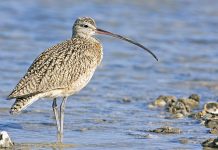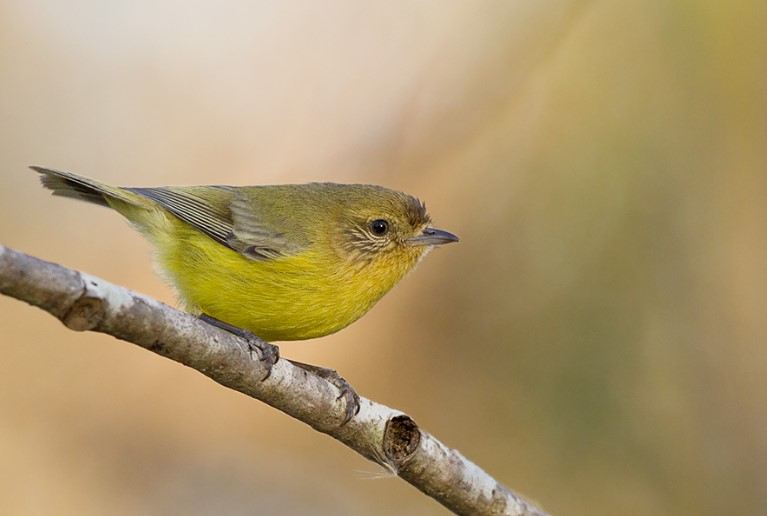Habitat: Little Shrike-thrush (Colluricincla megarhyncha) is a sedentary bird of closed-canopied vine forests, such as rainforests in northeastern Queensland, monsoon jungles in northwestern Australia, and mangroves along much of the northern Australian coastline.
Despite spending much of their time with mixed flocks of other birds, these birds also forage alone or in pairs, working their way methodically through every strata of the forest, from the canopy to the shrubbery at ground level.
The Little Shrike-thrush is part of a group of small, rainforest-dwelling shrike-thrushes in the southwestern Pacific, which include Bower’s Shrike-thrush and the Sooty Whistler’s Colluricincla umbrina of New Guinea. There is no difference between males and females in any of them.

Feed: The bird hops and flits deliberately from branch to branch, sifting through foliage and vine tangles, picking and gleaning, and even tearing away bark to expose prey. Among the large insects taken are spiders, beetles, and crabs, which can be found in mangrove swamps.
Races: The little shrike-thrush is the most variable species, with five races found in northern Australia. Four of them are in the east, between coastal northern New South Wales and the Cape York Peninsula.
Generally, they are rufous, pale-billed, and have streaks on the breast. Their sizes, tones, and breast streaking vary slightly. West of Arnhem Land and the Kimberleys lies the fifth race—black-billed, brown-backed, and white-breasted. A range of intermediate populations around the western head of the Gulf of Carpentaria link it to the eastern races, despite its appearance.
Identification: Both sexes are similar. In eastern races, the upper parts are russet-brown with variable gray blooms; wing and tail quills are darker, edged lighter brown, or rufous in the Ingham-Cooktown population. The face of the lower body is paler, and the lores and eyebrows are vaguely buff. Throat was whitish, grading to cinnamon-brown or pale rufous from breast to undertail, and streaked variably dusky over the breast.
The eyes are red-brown. Bill is pink-grey, washed darker on the culmen. The feet are pale gray. In the northwestern race, the upper parts are uniformly flat brown. Face pale gray-brown, with bright white lores and eyebrows.
Throat and upper breast white, grading to pale grey-fawn flanks and undertail; belly white; breast and throat extensively streaked dusky. The bill is black. The immature bird’s wing quills and upper wing coverts are russet-edged; the tail quills are tawny-buff at the base and pointed; the eye is brown.

Vocalizations: The little shrike-thrush sings an abbreviated song in contact; chirps and wheezes in alarm. The song consists of four to five clear whistles, the first rising, the rest shorter and more rapid on the same pitch, by both sexes. Singing subduedly than Grey Shrike Thrush As well as tearing open nests, it also protects the young of other birds.
They defend their territories by singing sporadic songs, especially in the early morning, up to several hectares in size. A non-stop medley of duets and medley-like songs is sung in border areas when neighbors of both sexes gather, tails cocked high, hopping excitedly around.
Nest and Breed: Nesting and breeding take place between September and February. Its nest is composed of dead skeletons and green leaves, bark strips, twigs, and (in eastern birds) sometimes moss, bound with tendrils and coated with cobwebs and cocoons.
It is lined with roots and thin plant stems. It is well camouflaged among vertical foliage forks, shrubs, vine tangles, lawyer canes, pandanus, and mangroves, as well as open sites, between 0.3 and 10 meters above ground.
Eggs: The bird lays two or three eggs; glossy and pearly white to pale pink-brown, freckled with varying amounts of olive, slate, or red-brown, particularly at the larger end; elongated to round-oval, variable in size, about 25 x 19 mm.
Distribution: Coastal and hill rainforests, vine scrubs, and mangroves around northern Australia, west to the mid-northwestern coast of Kimberley’s, WA, and south east to Barrington Tops, NSW. Most common in the lowlands Also in New Guinea are nearby islands and the Sangi Islands, near Celebes.
Alternative Names: It is also known as the Rufous Shrike Thrush.
Size: Little Shrike-thrush measures 170-190 mm long.
Read More: White-breasted Whistler – Nature’s Melodic Maestro







